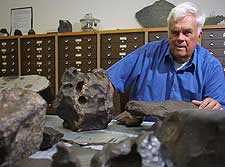Meteorites more Wrong than Right Arizona is one of the best places in the world to find a meteorite. An estimated 25,000 meteorites hit Earth each year. Most disappear into oceans or forests. In the desert, though, the meteorite's typical black, crusty exterior stands out. Theoretically, that makes meteorites easier to find. But your odds of finding one are still only slightly better than being struck by lightning. Carleton B. Moore says far more people find meteor-wrongs, not meteorites. He should know. As the director of Arizona State University's Center for Meteorite Studies, he gets more than 700 specimens annually, sent in for a free test. Most samples are iron ore, not meteorites. "We're lucky if it's one out of 1,000," he said. "What we really hope for is that we'll find a nice new one with a new clue. And you know somewhere on the ground is the new one."
More than 1,400 meteorites are in ASU's collection, making it the fourth largest in the world. A small museum is down the hall from Moore's office, but the majority of meteorites are catalogued and stored in a secure room, in boxes, on shelves and in drawers for study. Ten percent of the known locations where meteorites have hit in North America are in Arizona, according to Bill Peck, a geographic information specialist who maps sites. That's 80 known sites. Because meteorites could hold the answers to the origins of the universe, Moore keeps opening the boxes that come in the mail every day, he said.
Seeing meteorites• The Center for Meteorite Studies museum is open from 8 a.m. to 5 p.m. Monday through Friday in the C Wing of the George Batemen Physical Sciences Center at Arizona State University, south of University Drive and west of Rural Road in Tempe. Admission is free. (480) 965-3576.• Meteor Crater is open daily and is located off Interstate 40, 35 miles east of Flagstaff. Admission is $12 for adults, $11 for seniors and $5 for children ages 6 to 17. Children 5 and younger are free. Admission includes a guided rim tour, weather permitting, between 9:15 a.m. and 2:15 p.m. daily; entrance to the self-guided museum; and a short movie about the crater and its history. 1-800-289-5898.
• More about meteors, asteroids and other objects in space at space.azcentral.com. In recent years, people have been more interested in making money. Collectors have paid high prices for some meteorites, and people want to cash in. "They are worth more to science," Moore said. "The fact that some people pay a lot of money for them may not do science a good turn." In Tucson in February, a small, exotic specimen sold for $14,000 at an auction hosted by the Macovich Collection of Meteorites in New York. That price is rare, said Darryl Pitt, curator of the collection. At the gift shop at Meteor Crater in northern Arizona, meteorite fragments sell for $2 to $400. At 13, Pitt stood transfixed at the edge of Meteor Crater during a family vacation. His fascination with meteorites began, and he understands why people would want to own something from outer space that is 4 * billion years old and from the asteroid belt. "You see the stars in the sky," he said. "Wouldn't it be wonderful to have something in your hand that's tangible from outer space?" If you live on a ranch near Meteor Crater, which is about halfway between Flagstaff and Winslow, your chances of finding meteorites increase exponentially . Warren and Spencer Prosser, 17-year-old twins, recently sent tiny meteorite pieces to the center. They learned how to find meteorites with their grandpa, who bought the ranch in 1939. Their mom, Judy, remembers going out with her grandmother when she was growing up on the ranch. "It was just fun to find and then we'd weigh it," she said. "In her elder years, she didn't have a whole lot to do, and she spent a lot of time out there with her magnet on a stick. She was a collector." Fragments from the meteorite that hit 50,000 years ago spread miles from the impact site and left a mile-wide crater. Taking meteorites from the Meteor Crater site, private property or state-owned land is illegal, according to Robyn Messerschmidt at Meteor Crater's visitors' center. Most people who are told they have meteor-wrongs are reasonable, said Blaine Comeaux, 31, an ASU research assistant in the department and a Tempe resident. "Then you get that 10 percent, and they think they are going to make a million. They get really upset when their dreams don't come true," Comeaux said. But, a meteorite hitting your 1980 Chevy Impala improves its resale value. In 1992, a meteorite hit the car, worth maybe $500 pre-meteorite damage, in Peekskill, N.Y. The car sold for $10,000. A picture of the car, a model of the meteorite and a portion of the meteorite are at the ASU museum. |


